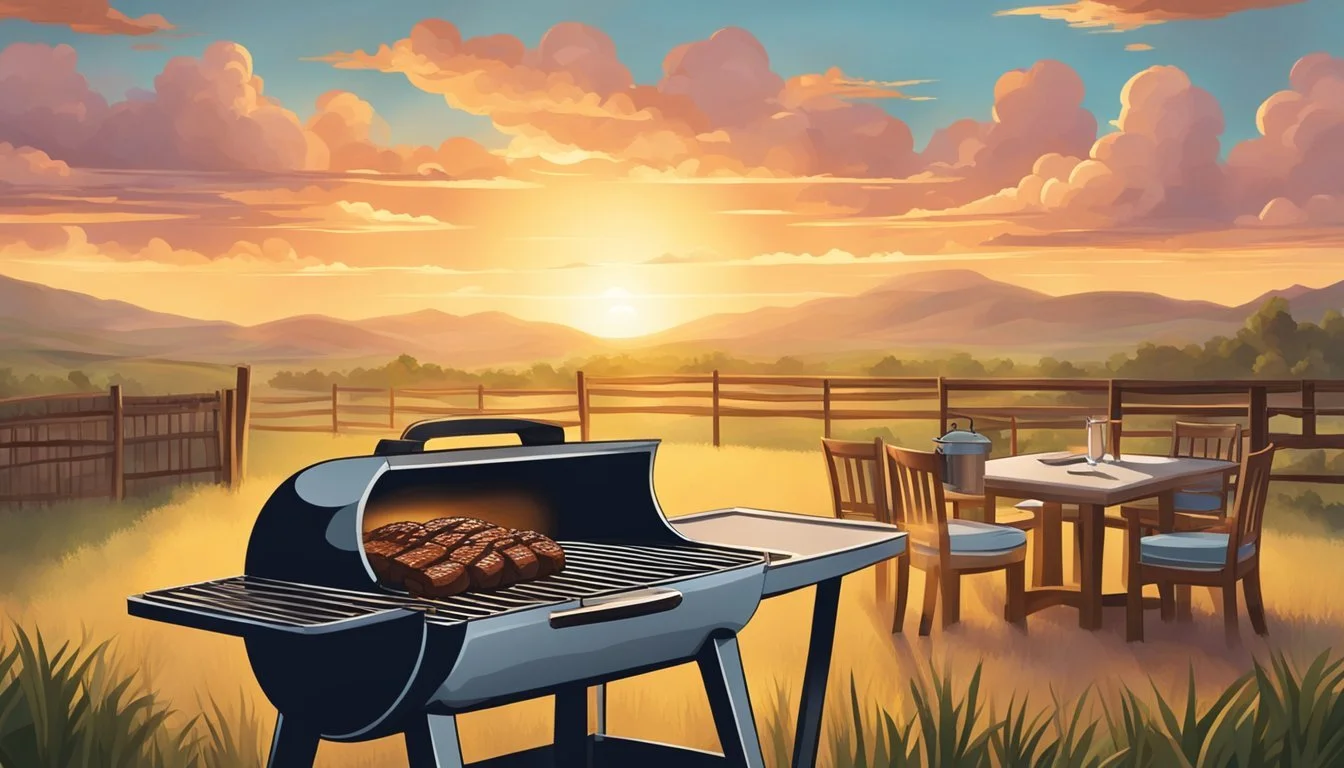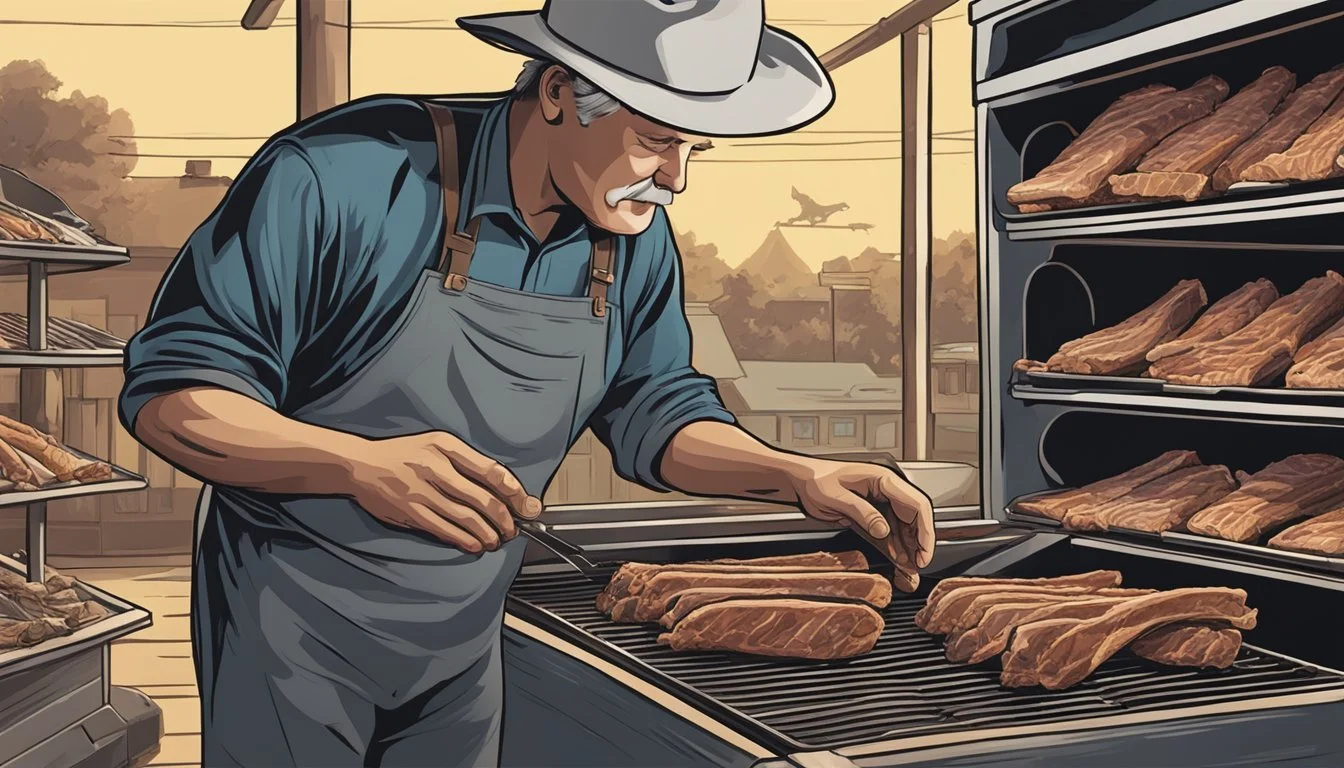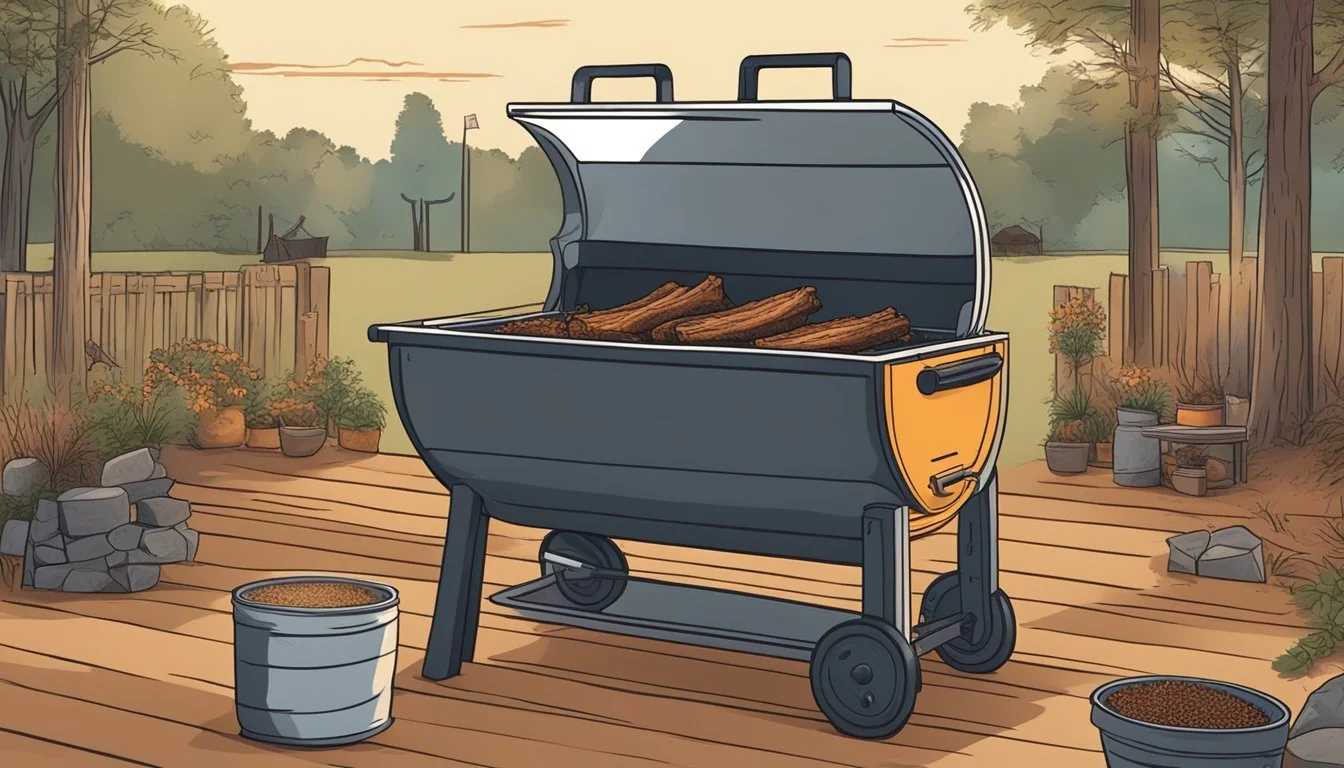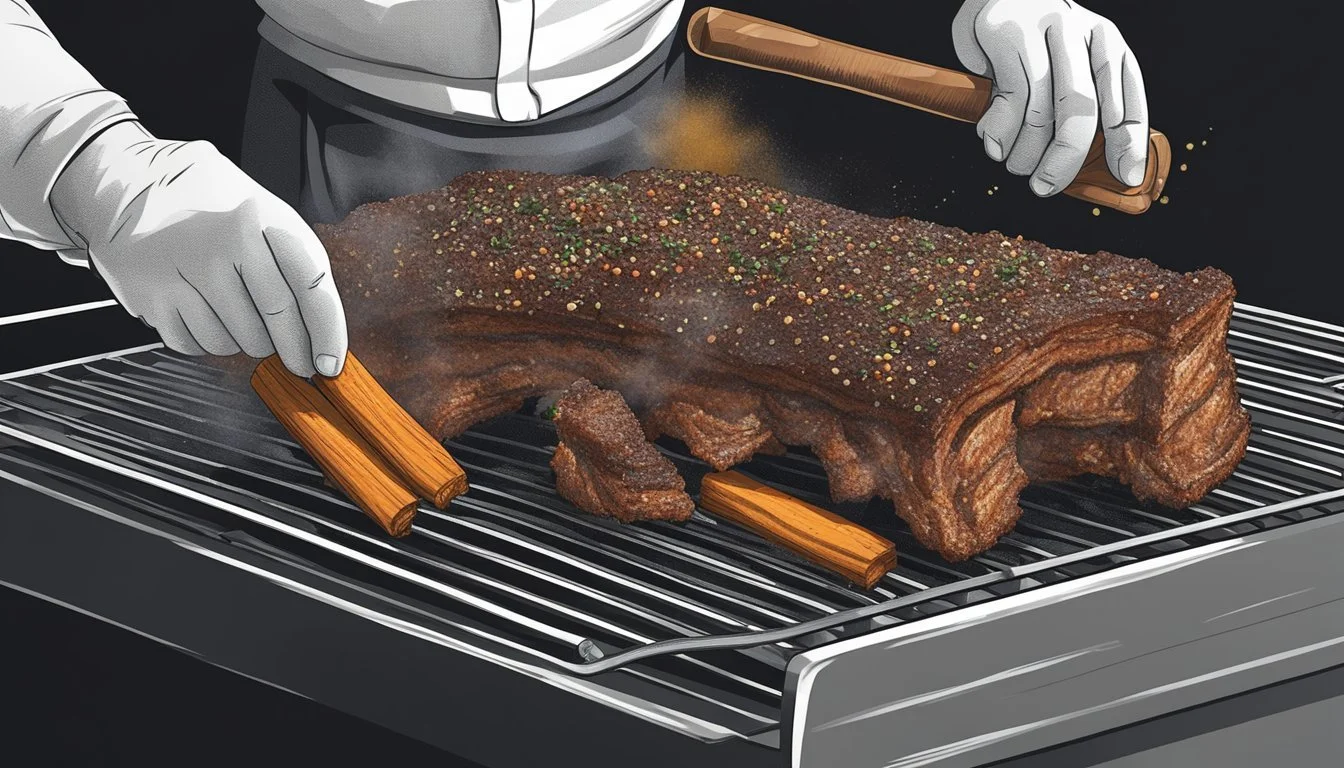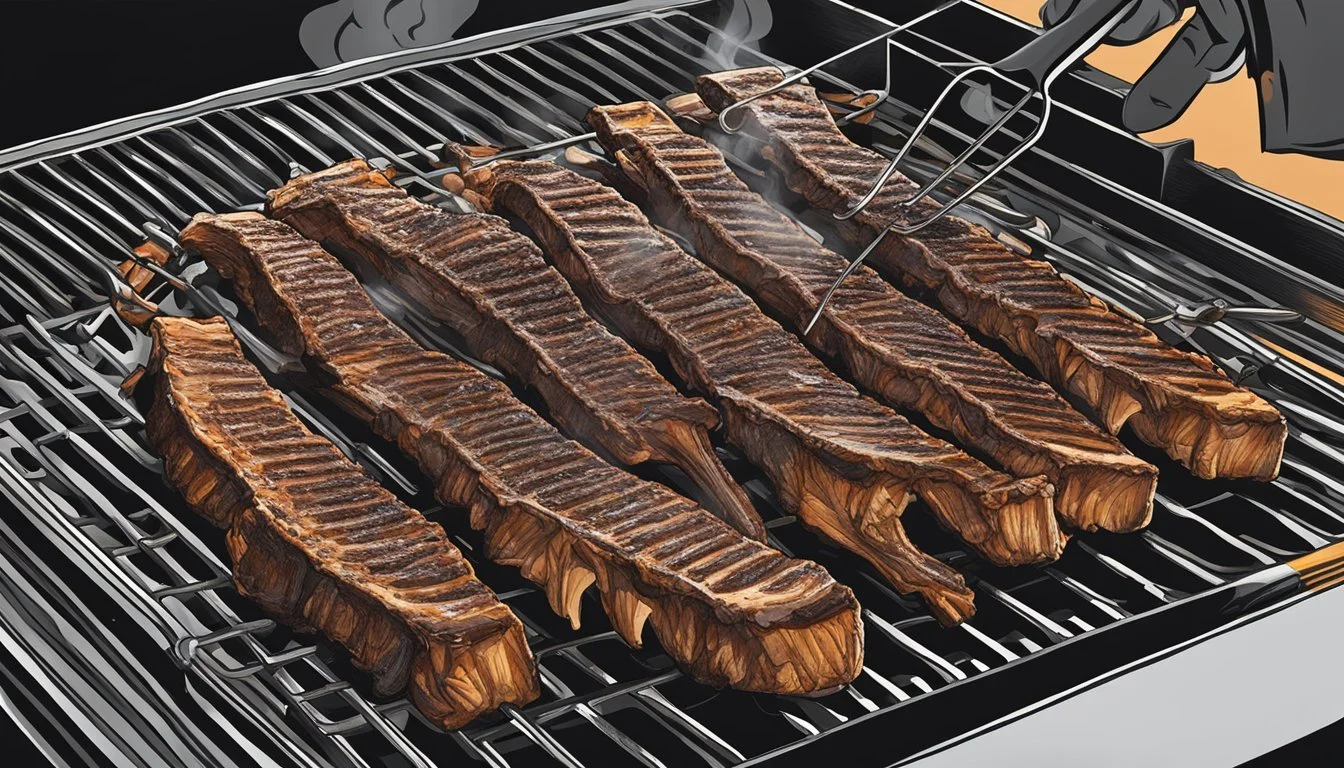Smoking Ribs in Texas
A Guide to Perfecting the Lone Star Tradition
Smoking ribs is an art form deeply rooted in the heart of Texas BBQ culture, a culinary tradition that garners respect and admiration from barbecue (What wine goes well with barbecue?) enthusiasts globally. In Texas, smoking not only imparts rich, complex flavors into the meat but also serves as a rite of passage for pitmasters looking to leave their mark on the storied Texan barbecue landscape. Smoked beef ribs, in particular, stand tall among the state's array of smokey delicacies. They are known for their substantial size—often referred to as "dino ribs"—and the skill required to render cuts of ribs perfectly tender.
The process of smoking these substantial cuts involves a balance of heat, timing, and spice. Seasoning is paramount in achieving authentic Texas BBQ flavor; it often begins with simple yet effective rubs that enhance the robust taste of beef without overpowering it. A blend of salt and coarse ground black pepper, sometimes known as "Dalmatian rub," is common, paying homage to the simplicity of ingredients that lets the meat shine. The smoker is the pitmaster's primary tool, generally maintained at a steady low temperature—ideally around 250 to 275 degrees Fahrenheit for pork ribs (What wine goes well with pork ribs?) recipe. This low and slow approach allows the fat to slowly render and the meat to absorb the smoke, resulting in ribs that are juicy, smoky, and deeply satisfying.
As the ribs undergo their hours-long transformation in the smoker, the significance of patience becomes apparent. The meat's flavors are enhanced through a combination of the smoke and a meticulous cooking process that can't be rushed. Utilizing woods like oak, mesquite, or pecan, Texas pitmasters coax the meat to its peak, creating a bark on the exterior that gives way to tender meat that pulls cleanly off the bone. The dedication to craft evident in each rack of ribs reflects the cultural importance of barbecue in Texas and underscores why smoked ribs are not just a meal in the Lone Star State, but an experience to be savored.
Essential Equipment
In the pursuit of smoking ribs to perfection, having the right equipment is crucial—both in terms of the hardware for cooking and the choice of wood for flavor.
Choosing the Right Smoker
The centerpiece of any rib-smoking setup is the smoker. Different types provide varying flavors and experiences. Electric smokers make for a convenient and consistent heat source, producing a clean smoky flavor without much fuss. For a more hands-on approach that is celebrated in Texas, offset smokers, which separate the firebox from the cooking chamber, offer a traditional method and better flavor control. When selecting a smoker:
Size: Ensure it can accommodate multiple racks of ribs.
Temperature Control: Look for a smoker that maintains a steady temperature, which is crucial for even cooking.
Build Quality: Choose a smoker with durable construction to withstand high temperatures and long cooking times.
Understanding Wood Choices
The type of wood used can significantly influence the flavor of the ribs. Texas barbecue is renowned for its use of post oak, which imparts a mild, smoky essence. For a sweeter taste, fruit woods like apple or cherry are popular. When preparing the wood:
Soak Wood Chips: If using chips, soak them in water prior to smoking to ensure a slow burn and steady smoke production.
Avoid Resinous Woods: Woods like pine can introduce unpleasant flavors and should be avoided.
By focusing on the quality and appropriateness of both the smoker and wood, cooks can elevate the taste and texture of their smoked ribs, aiming for that authentic Texas barbecue experience.
Selecting Ribs
Choosing the right type of ribs and ensuring their quality is essential for a successful Texas-style barbecue. The selection process can deeply impact the flavor and texture of the finished dish.
Beef vs. Pork Ribs
Beef ribs are typically larger and have more meat around the bones, lending a hearty, bold flavor that stands up well to the smoky barbecue process. Conversely, pork ribs, such as St. Louis or baby back ribs, are smaller with a higher fat content, which can translate to a tender, more succulent bite when cooked properly. For an authentic Texas experience, many opt for beef ribs due to their robust size and flavor.
Beef Ribs: Strong, rich taste; larger size; longer cook time.
Pork Ribs: Higher fat content; more tender; shorter cook time.
Identifying Quality Meat
When selecting ribs for smoking, there are certain indicators of quality to look for regardless of the type:
Marbling: Look for ribs with a good amount of fat marbling throughout the meat, which promotes juiciness and flavor.
Color: The meat should have a fresh, pinkish-red color without any grayish tones.
Texture: Meat should feel firm to the touch and bounce back when pressed. If the meat feels slimy or sticky, it’s a sign of poor quality.
Smell: Fresh ribs should have a clean, almost sweet smell. Any sour or off odors indicate that the ribs are not fresh.
The ‘Snap Test’: Hold a rack of ribs by one end with a pair of tongs. They should sag with their own weight but not fall apart, indicating the right amount of connective tissue.
Purchasing from reputable butchers or grocery stores is advisable as they can provide higher quality meat than standard supermarkets. Remember to check for an even and consistent size in the racks to ensure uniform cooking times.
Preparation Techniques
Proper preparation is the cornerstone of mouthwatering Texas-style smoked ribs. The process begins with two essential steps: trimming and membrane removal, each crucial for achieving the perfect texture and flavor.
Trimming the Ribs
Start by laying out the rack of ribs on a stable, flat surface, ideally on a rimmed baking sheet to contain any juices. With a sharp knife, trim off any excess fat, which can cause flare-ups or lead to greasy results. While some fat is desirable for moisture and flavor, aim for a thin, even layer. If there are any loose meat pieces or bone bits, remove those as well. A clean-cut rack ensures even cooking and a presentation that's sure to impress.
Removing the Membrane
On the bone side of the ribs, there's a shiny, tough layer known as the silver skin or membrane. For bone-tender ribs, it’s imperative to remove this membrane as it prevents seasonings from penetrating the meat and can result in a tough texture. Slide a butter knife under the membrane at one end of the ribs, lift to loosen, and then grab it with a piece of paper towel for a better grip. Peel the membrane off in one piece if possible. Removing this allows the ribs to better absorb the smoky flavor during cooking and results in a more palatable texture.
Crafting the Perfect Rub
The key to delectable Texas-style smoked ribs lies in a well-crafted rub, which can elevate the meat's flavor profile significantly.
Balancing Flavors
In Texas BBQ, the rub is a critical component, forming a crust that encapsulates smoky flavorsWhat wine goes well with smoky flavors? () and seals in moisture. For a balanced rub, start with a base of kosher salt and black pepper to enhance the meat's natural flavor. Add paprika for color and sweetness, and ground cumin for a warm, earthy undertone. Incorporate onion and garlic powder (how long does garlic powder last?) for savory notes, and mustard powder (how long does mustard powder last?) for tang. A hint of brown sugar can introduce a caramelized sweetness that contrasts with the smoky taste, but remember that too much sugar can burn at high temperatures.
Balanced proportions might typically look like this:
4 parts kosher salt
4 parts ground black pepper
3 parts paprika
2 parts onion powder (how long does onion powder last?)
2 parts garlic powder
1 part mustard powder
1 part ground cumin
1 part brown sugar
Adjust these ratios according to your taste preferences and the meat's weight.
Applying the Rub
Before applying the rub, pat the rack of ribs dry with paper towels to ensure the spices adhere properly. Slathering a light coat of yellow mustard on the ribs can act as a 'glue' for the rub, but it’s an optional step and doesn't impart a mustard flavor after cooking.
Spread the rub evenly over the surface of the meat, using the back of a butter knife to gently press and secure the rub into the connective tissue. It’s beneficial to let the ribs sit with the rub applied for at least 30 minutes before smoking; this time allows the salt to draw out moisture, creating a tacky surface for the smoke to cling to.
While some backyard enthusiasts prefer to wrap their ribs in foil during cooking to retain moisture, others argue that leaving the ribs unwrapped for the entire cook time on the smoker results in a better smoke ring and flavor. If opting for the wrap method, introduce a mixture of apple juice, a few pats of butter, and maybe even more rub inside the foil to add moisture and richness. Reintroduce the ribs onto the grill either in their foil for a tender result or without for a couple of hours to solidify the bark.
Remember, achieving bone-tender ribs with that perfect smoky flavor is as much about technique as it is about the spice blend itself.
Smoking Process
Smoking ribs in Texas is an art that combines attention to detail with a timeless tradition. Mastery of temperature control and the low and slow cooking philosophy are essential for achieving the quintessential tender and flavorful ribs.
Managing Temperature
Proper temperature management is the cornerstone of successful rib smoking. Ribs should be cooked at a consistent temperature, typically between 225°F and 250°F. Maintaining a steady temperature ensures that the meat cooks evenly and the smoky flavor permeates throughout. Digital meat thermometers are recommended for monitoring the internal temperature, which is crucial to avoid undercooking or overcooking. Keeping chips in water before using them can help regulate temperature and smoke levels to infuse the smoky essence without overpowering the meat.
Initial Setup: Preheat your smoker to the target temperature range before you transfer ribs on the grill grates.
Monitoring: Check temperatures every hour, adjusting vents or adding fuel to maintain consistent heat.
Tools: Utilize digital meat thermometers to check meat doneness without frequent opening of the smoker which can cause temperature fluctuations.
The Low and Slow Philosophy
The "low and slow" approach is the bedrock of the Texas rib smoking process, allowing time for the connective tissue within the rib meat to break down and resulting in supremely tender ribs. This method involves several steps including wrapping the ribs and incorporating liquids for enhanced moisture.
Wrapping Ribs: After several hours of smoking, typically at the 3-hour mark, wrap the ribs in foil or butcher paper with a splash of apple juice or apple cider vinegar (how long does apple cider vinegar last?) to tenderize the meat and prevent drying out.
Finishing: Unwrap the ribs during the final hour of cook time to firm up the exterior for that perfect bite through the smoky flavor-laden crust.
Resting: Once the desired internal temperature is reached—a rule of thumb is 190°F to 205°F for pork ribs—remove the ribs from the smoker and let them rest. This allows juices to redistribute for optimal tenderness.
Employing strict temperature control along with the low and slow philosophy will endow your ribs with the characteristic Texas taste and texture that is desired at backyard cookouts and barbecue competitions alike.
Wrapping Techniques
When smoking ribs in Texas, wrapping is a critical step to achieve perfectly tender and moist results. There are two popular methods of wrapping: using aluminum foil or butcher paper.
Foil vs. Butcher Paper
Aluminum Foil offers an efficient way to lock in moisture and heat. Wrapping ribs in foil typically shortens cooking time as it creates a steamy environment, helping to break down connective tissues more quickly, leading to tender ribs. Foil is widely available and is a standard in many smoking recipes.
Pros: Speeds up cook time, locks in moisture effectively.
Cons: Can soften the bark too much, leading to less texture.
Butcher Paper, on the other hand, is preferred by some pitmasters for its breathability. It allows some of the smoke to continue permeating the meat without drying it out, balancing the benefits of wrapping with retaining a smoky flavor profile.
Pros: Preserves a firmer bark, allows smoke flavor to develop.
Cons: Less moisture retention than foil, potentially longer cook time.
Locking In Moisture
To ensure ribs remain juicy, incorporating a liquid such as apple juice or apple cider vinegar before wrapping can be beneficial. This not only adds flavor but also steams the meat within the wrap.
For Foil: Combine a light brushing of barbecue sauce with a splash of apple juice around the ribs before sealing the foil tightly.
For Butcher Paper: Slightly dampen the paper with your chosen liquid to maintain humidity around the meat while it finishes cooking.
In both techniques, monitor the internal temperature; ribs are done when they reach an internal temperature of around 195º to 205ºF. Whether using foil or butcher paper, wrapping should be done at the midpoint of the cooking process, once the ribs have absorbed adequate smoke and the temperature stalls, typically after 2-3 hours of initial cooking.
Saucing and Seasoning
Perfecting the art of saucing and seasoning is crucial to achieving mouthwatering Texas smoked ribs. The balance between a well-crafted rub and the timing of sauce application can make or break the smoky flavor and tenderness of the ribs.
Homemade vs. Store-bought Sauces
When selecting a barbecue sauce for ribs, pitmasters face a choice between homemade and store-bought options. Homemade sauces allow for customization, letting you balance sweet, tangy, and spicy flavors to your preference. Ingredients like apple cider vinegar and a touch of yellow mustard can enhance homemade sauces. On the other hand, store-bought sauces offer convenience and consistent flavor, with popular brands like Sweet Baby Ray's frequently found at backyard cookouts. For a truly Texan taste, look for sauces that have a hint of heat and a complex flavor profile.
Homemade Sauce Pros: Customizable, controlled ingredients
Store-bought Sauce Pros: Convenience, consistent taste
Timing Your Basting
The application of sauce to ribs should be timed carefully to avoid burning the sugars in the sauce and to achieve a sticky, caramelized coating. A good rule of thumb is to apply the barbecue sauce only during the last 30-60 minutes of cook time, once the ribs have reached an internal temperature that's close to the desired tenderness.
Pre-Wrapping: A thin layer of sauce or yellow mustard can be applied to the rack of ribs before the initial rub, helping to bind the seasoning.
During Smoking: Resist saucing too soon. Instead, let the meat develop a crust and absorb smoky flavor.
Post-Wrapping: If you choose to wrap ribs in foil or butcher paper, you might include a small amount of liquid like apple juice to steam the meat inside the wrap.
Finishing: Spread an even layer of sauce over the ribs once they are nearly finished cooking and return them to the smoker or grill to set the sauce.
By understanding the nuances of saucing and seasoning, cooks can turn a simple rack of ribs into a culinary masterpiece, showcasing the robust flavors and tender textures that Texas smoked ribs are known for.
Finishing Touches
As the smoking process draws to a close, achieving the ideal finish on a rack of pork ribs is crucial for texture, flavor, and presentation. Attention to detail in the final stages can make a significant difference in the quality of the meat.
Resting the Meat
Once removed from the smoker, it's imperative to let the ribs rest. This pause allows the internal temperature of the meat to stabilize and the juices to redistribute. Wrap the ribs tightly in butcher paper or foil and rest them on a rimmed baking sheet to avoid any mess. The duration of this rest typically ranges from 10 to 15 minutes for bone tender ribs, allowing the residual heat to continue working its magic, ensuring that every bite is succulent.
Slicing for Serving
To serve ribs that hold together with a clean cut yet pull easily from the bone, a sharp knife is essential. Begin by positioning the ribs so the concave center faces upward, exposing the individual rib bones. Slide a butter knife between the bones to find the natural division, and use paper towels to maintain a strong grip. Slice with confidence and precision, aiming for cuts of even thickness. If prepared correctly, the ribs should exhibit a smoky flavor-infused exterior with a succulent interior, offering a harmonious balance on the plate.
Serving and Sides
When smoking ribs in Texas, the attention to detail doesn't end with the main course. The sides served and the presentation of the meal play pivotal roles in ensuring the whole dining experience is a resounding success.
Complementary Flavors
Traditionally, Texas BBQ ribs thrive alongside bold and hearty sides. Pinto beans (how long does pinto beans last?) seasoned with smoked bacon, cilantro, and garlic elevate the plate with both texture and taste. A side of smoky baked beans (how long di baked beans last?) complements the rich, meaty flavor of ribs, often including a touch of sweetness to balance the savory notes. A classic hushpuppy provides a crispy contrast to tender ribs, with its deep-fried golden crust and soft, savory center.
For a refreshing counterpoint, consider incorporating a pico de gallo—the fresh tomato, onion, and cilantro medley is not only flavorful but also provides a vibrant visual appeal to the plate. Coleslaw, dressed lightly with vinegar or mayonnaise, offers a crisp and tangy element that cuts through the fattiness of the ribs, refreshing the palate.
Pinto beans with smoked bacon and garlic
Smoked baked beans
Hushpuppies
Pico de gallo
Coleslaw
Recommendations for Presentation
First impressions are vital, and presenting smoked ribs demands a strategy that honors the meat's texture and flavor. Plating begins with a rack of ribs—properly rested and gleaming with a light coating of BBQ sauce for a glistening finish. A light mist of apple juice right before serving can maintain the smoky flavors and add a subtle sweetness.
For a visually appealing layout, place the ribs on a warm platter, allowing the bones to create a natural arc that showcases the meat's succulence. Equip your guests with paper towels to manage the delicious mess that authentic Texas BBQ guarantees. If ribs are served directly from the smoker, implement a brief rest period wrapped in butcher paper or foil to let the juices redistribute, ensuring that every bite is as juicy as the last.
Presentation Tips:
Rest the ribs before serving to allow juices to redistribute.
Gently coat the ribs with BBQ sauce for a glistening appearance.
Serve with paper towels for a hands-on eating experience.
Lay ribs in a natural arc on the platter to highlight their succulence.
In sum, pairing smoked ribs with sides that complement the smoky flavor and presenting them attractively is essential for a truly memorable Texas BBQ experience.
Pro Techniques and Tips
In Texas, smoking ribs is an art form that requires mastery over maintaining a robust smoky crust and regulating moisture for succulent results.
Achieving a Smoky Crust
To create a smoky crust on ribs, they often start with a thorough rub application. Before applying any rub, a butcher paper or paper towels can be used to dry the rack of ribs. A coat of yellow mustard can serve as a binder, ensuring that the dry rub adheres evenly. Kosher salt and ground black pepper form the foundation of a traditional rub, often enhanced with ground onion and ground cumin for depth. As the ribs cook, a desirable crust forms, encapsulating the spicy flavor that will permeate the meat. For wood, many Texans favor fruit woods like pecan, or a mix including hickory for more complex smoky flavor. The internal temperature of the meat is critical, aiming for a range where the connective tissue breaks down—between 190°F and 205°F ensures bone tender ribs without turning the meat mushy.
Regulating Moisture
To keep the ribs moist during the lengthy cooking time, proficient grillers often employ a two-phase cooking process known as the "Texas Crutch." After smoking the ribs directly on the grill grates for a few hours to impart a smoky flavor, they transfer the ribs from smoker to ribs in foil with a small amount of liquid, like apple juice or apple cider vinegar, to trap steam and accelerate the cooking during this stall period. A few pats of butter may also be added before sealing the foil. This not only speeds up the cooking time but also infuses moisture. After reaching the desired temperature, they carefully wrap ribs from foil to finish them on the smoker, allowing the exterior to firm up again, creating that cherished barbecue texture. Ribs may be basted with barbecue sauce in the final minutes to add a sweet or spicy flavor profile, depending on the sauce selection, like Sweet Baby Ray's. In any case, the sauce should not overpower but rather complement the true star—the rib itself.
Beyond the Smoker
Once the ribs have been perfectly smoked, the journey of flavor doesn't end there. Understanding how to handle the ribs post-smoking is crucial for maintaining taste and texture.
Storing Leftovers
Leftover ribs should be stored properly to preserve their smoky flavor and tenderness. To store, let ribs cool to room temperature first but no longer than two hours to prevent bacterial growth. Wrap the ribs tightly in aluminum foil or butcher paper, and then in plastic wrap to seal in the moisture. Ribs can be stored in the refrigerator for up to three to four days. For longer storage, place the wrapped ribs in a freezer bag and freeze for up to three months. To reheat, thaw overnight in the refrigerator if frozen, and warm in a 250°F oven until the internal temperature reaches 165°F.
Creative Recipes and Uses
Leftover ribs can be the star in a variety of creative dishes. Boldly infuse traditional recipes with the unique smoky flavor of the leftover ribs.
BBQ Rib Mac and Cheese: Chop rib meat and mix into creamy mac and cheese for a smoky twist.
Rib-stuffed Omelets: Enhance your breakfast by adding rib meat into omelets, along with cheddar cheese and diced onions.
For a quick meal, sauté rib meat with bell peppers and onion, then serve over rice or wrapped in a warm tortilla for a smoky rib fajita. Always ensure the leftover rib meat is reheated to the proper internal temperature before consuming.
Conlusion
In conclusion, the art of smoking ribs in the heart of Texas BBQ culture is a meticulous process that requires precision and a profound respect for culinary traditions. From choosing the right cuts and perfecting the seasoning process to achieving the ideal smoky crust and tenderness through low and slow smoking, each step contributes to an authentic Texas barbecue experience. The commitment of pitmasters, the thoughtful selection of equipment, and the harmonious balance of flavors in rubs and sauces all play a pivotal role in crafting ribs that serve as a testament to the cultural significance of barbecue in Texas.
Moving beyond the smoker, the meticulous attention to detail persists through careful resting, slicing, and presentation, ensuring a truly unforgettable dining experience. Pro techniques and tips shared by seasoned pitmasters emphasize the dedication required for a successful outcome. Smoking ribs in Texas transcends the act of cooking; it is a celebration of culture, tradition, and the relentless pursuit of excellence. So, whether you're employing a hot grill, rib rack, or bone ribs, each meticulously smoked rib narrates a tale of patience, dedication, and a genuine passion for the bold and flavorful essence that characterizes Texas BBQ. Say goodbye to bland cookouts—smoking ribs in Texas is an art form meant to be cherished and applauded.

